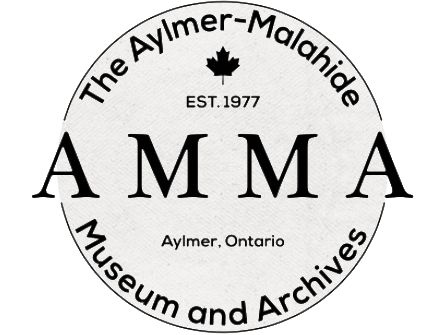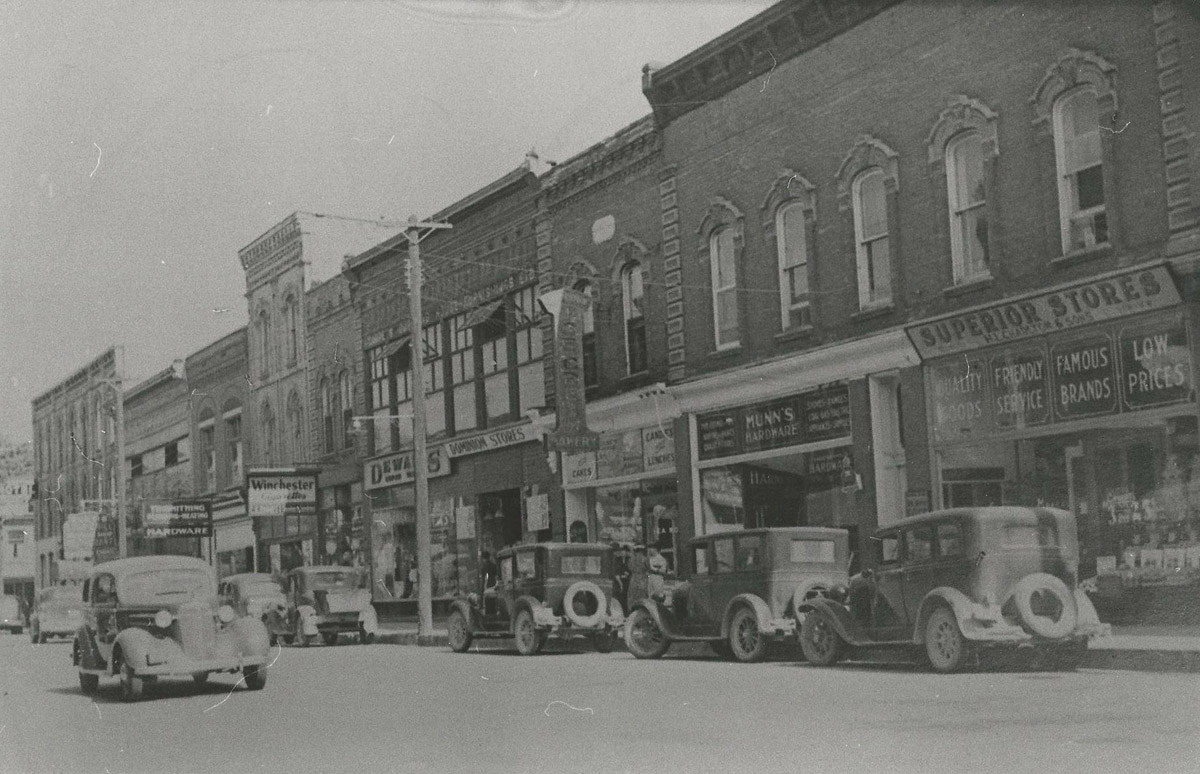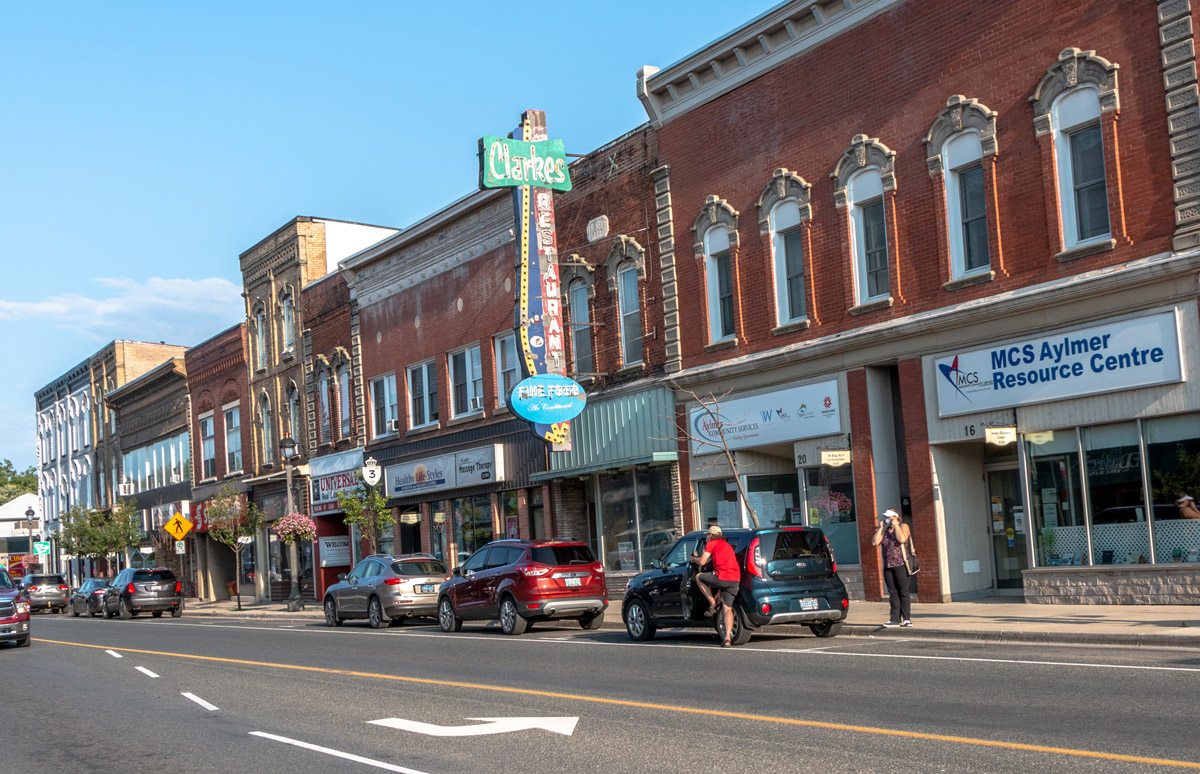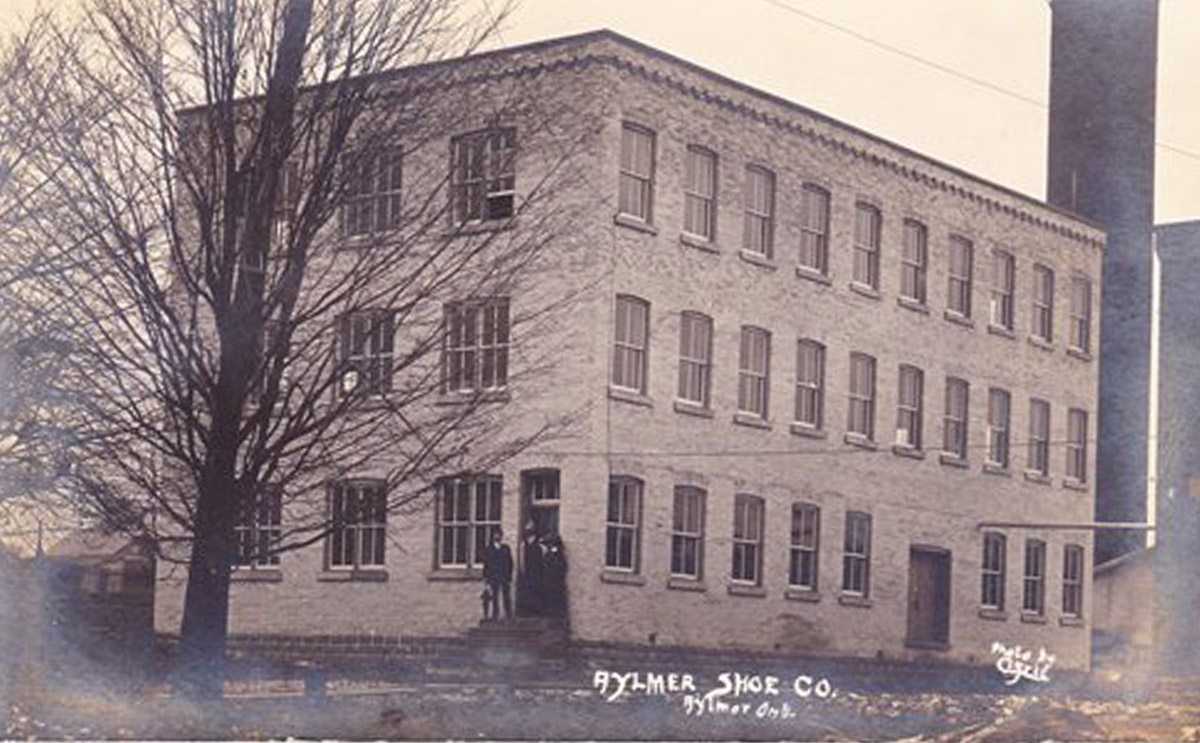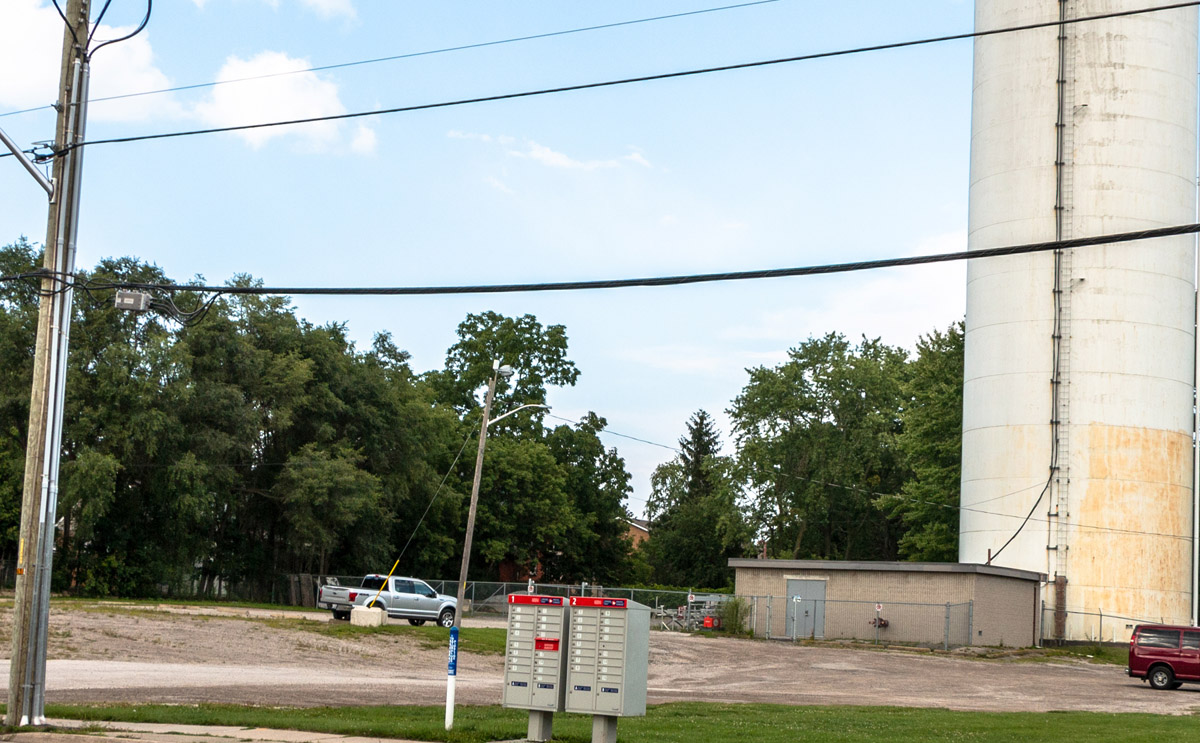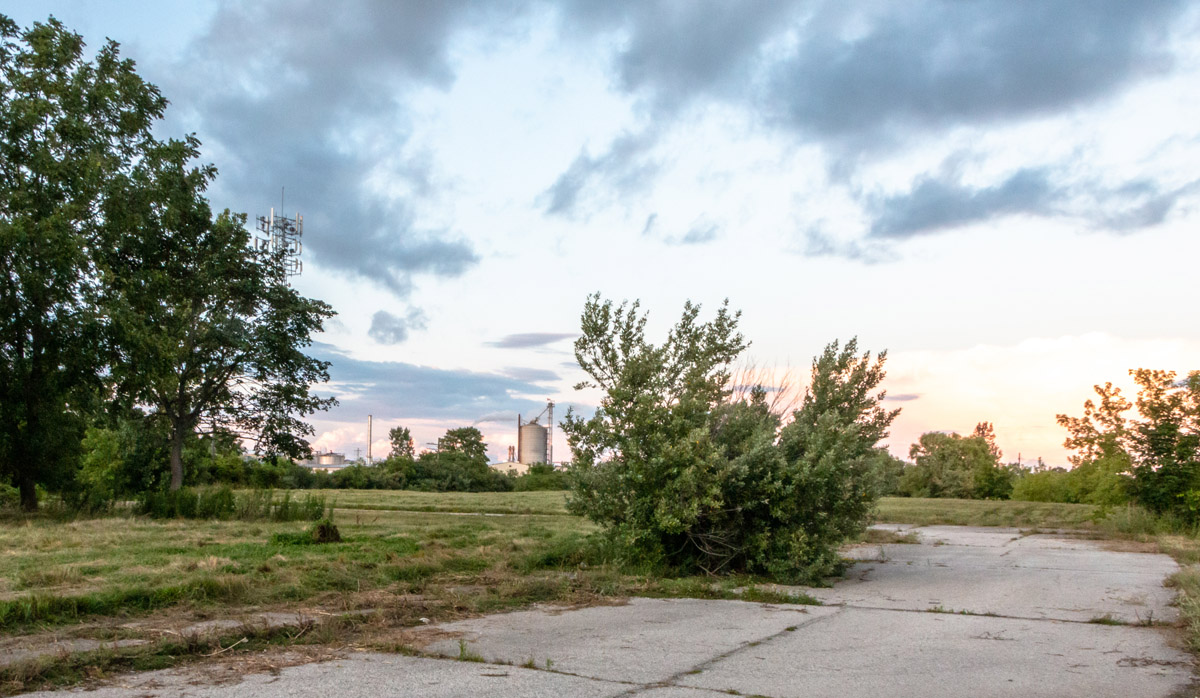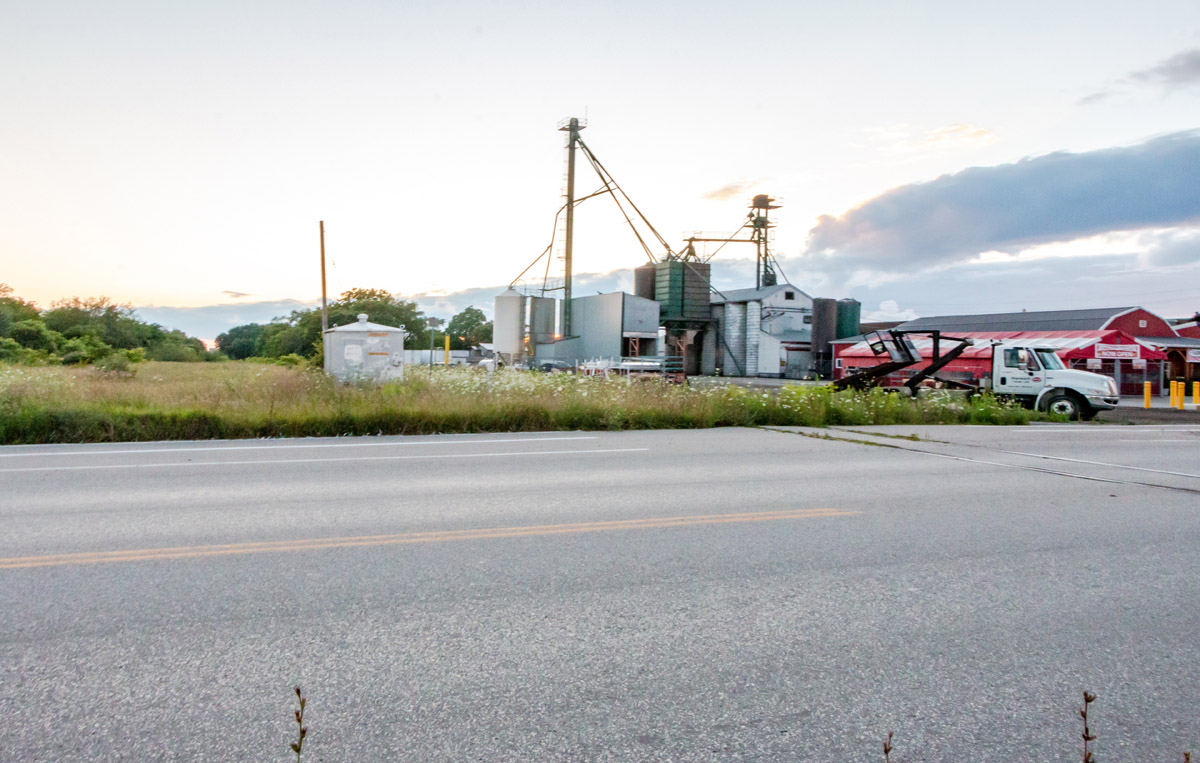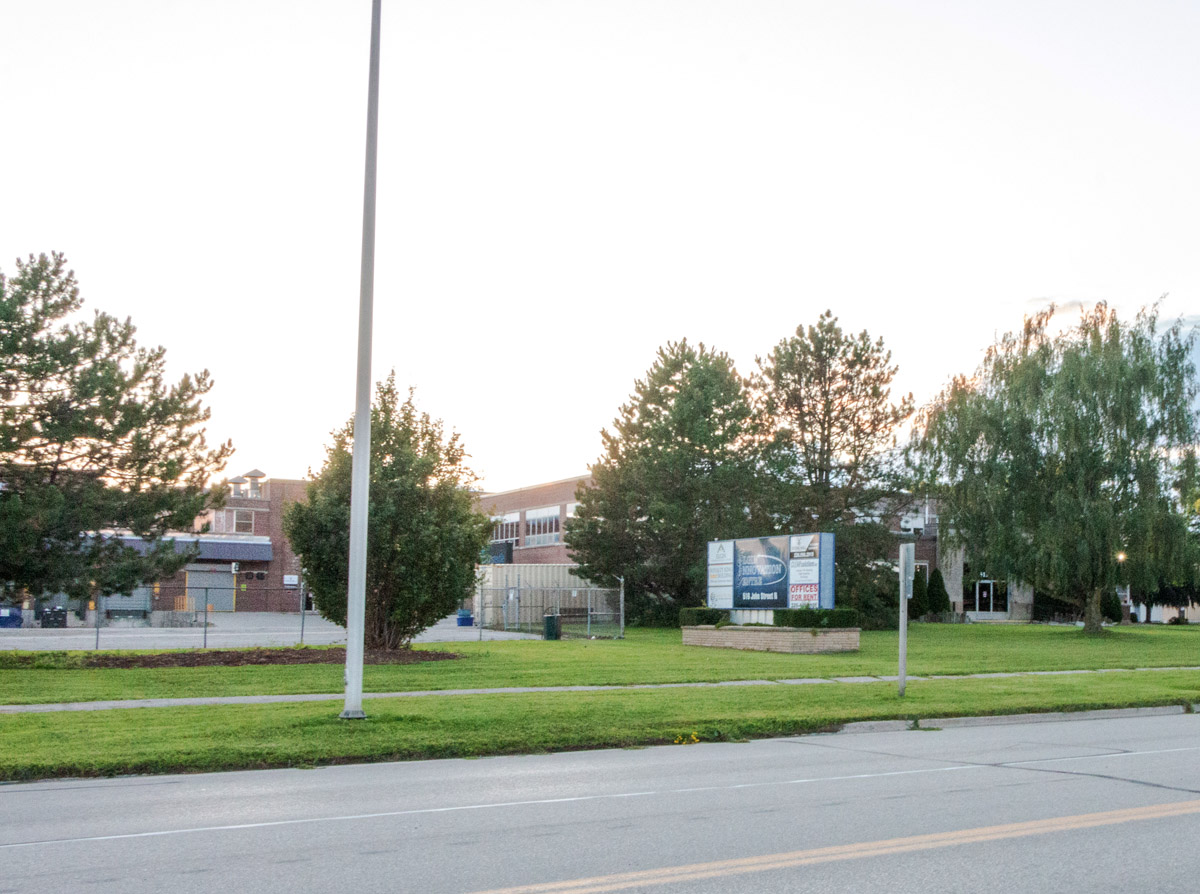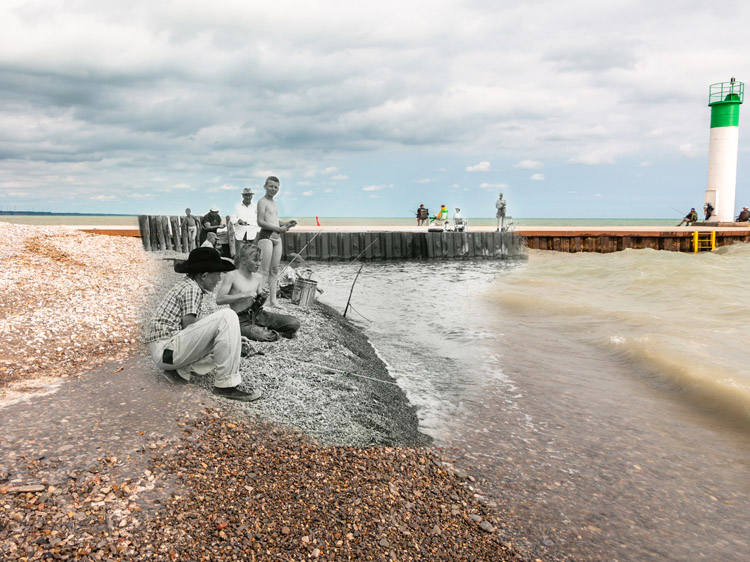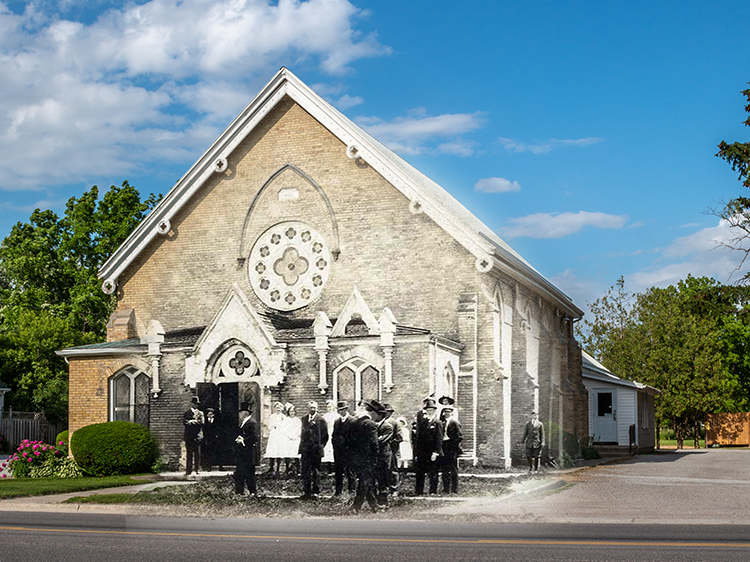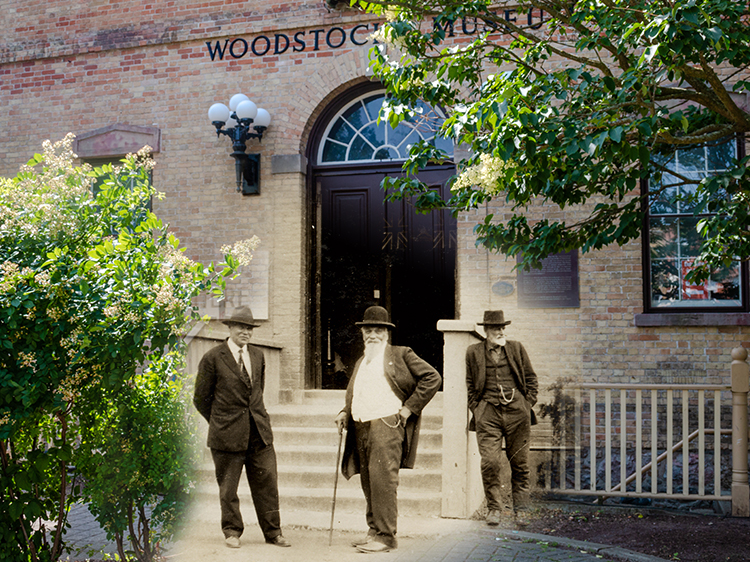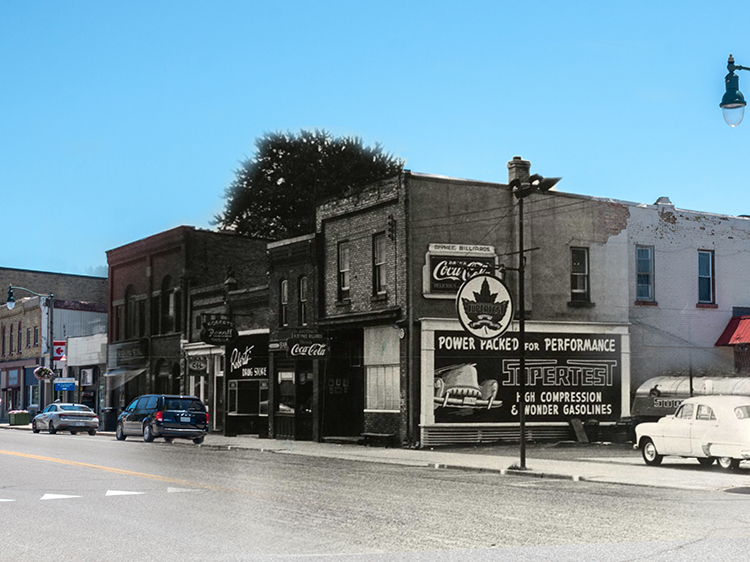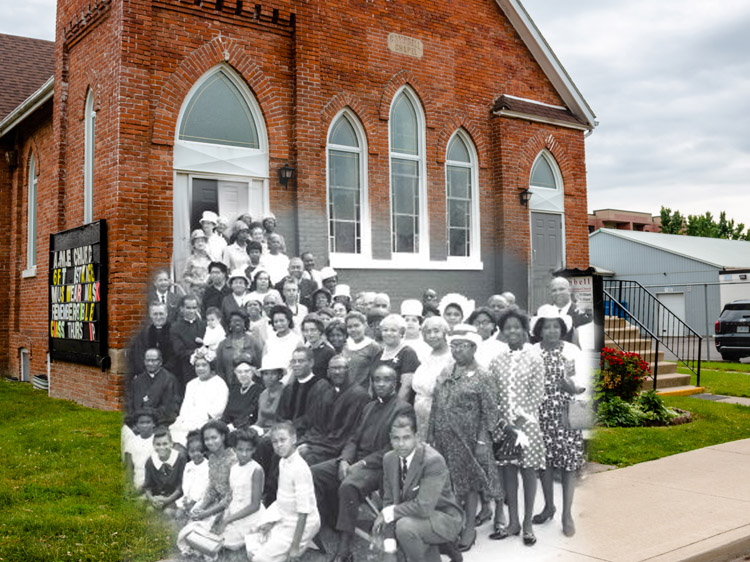Walking Tour
Aylmer's Industrial Past
Labour and Industry
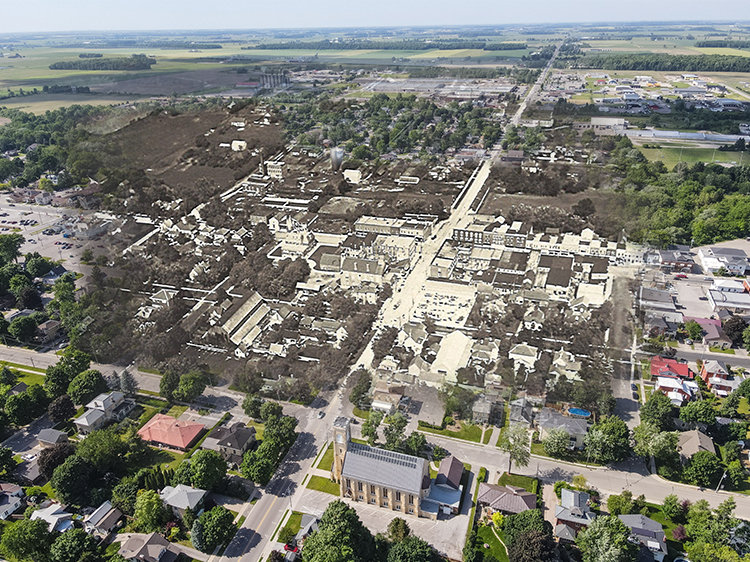
Aylmer-Malahide Museum & Archives
Ever since Aylmer's founding, its citizens have shown great entrepreneurial spirit. Many businesses and industries were conceived, grew, and declined in Aylmer, leaving an important legacy on this town. In this tour we will delve into the stories of some of those businesses. From the huge Aylmer Canning Company facilities, to the early history of shoemaking, and the condensed milk industry. We'll also learn about the connection Canada's greatest ace, Billy Bishop, had to Aylmer, and the story of the Mennonite Community that settled in Aylmer and continues to have an important presence here.
This project is a partnership with the Aylmer-Malahide Museum & Archives.
1. Aylmer Canners: The Beginning
Aylmer-Malahide Museum & Archives
The original Aylmer Canning Company buildings are pictured here some time between 1880 and the early 1900s. In the photo, there are a few structures visible, including the canning facility and storage places for goods, equipment, and produce. The Aylmer Canning Company was one of the first of its kind in Canada, and its legacy persists today.1
* * *
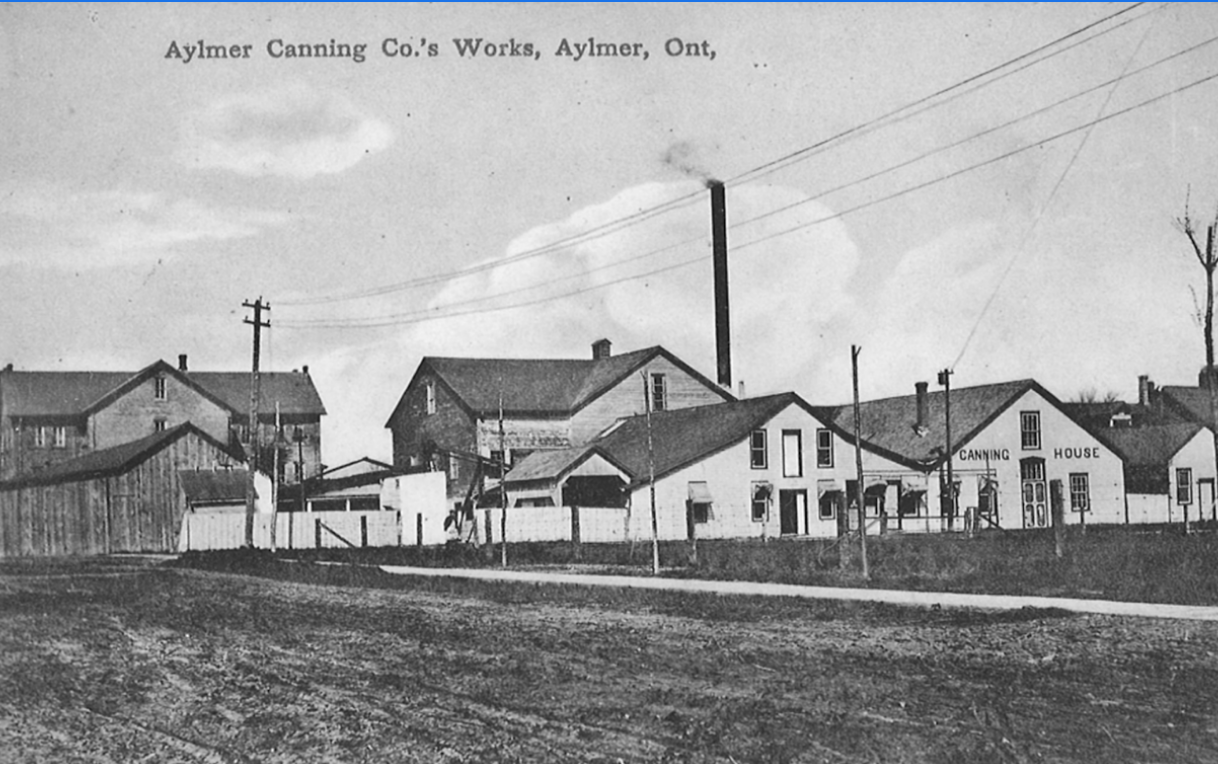
The Aylmer Canning Company was registered on June 16, 1881, with shares divided between seven prominent Aylmer businessmen.
David Marshall, the largest shareholder, was known for Red Star Grocery, a well-known brand in Aylmer and across Southern Ontario. Jehiel Yorke was the first president of the company. Yorke was the owner of the Elgin Pork Factory at the time, although he later sold this company to fellow shareholder George I. Walker. Walker also co-owned a number of businesses with his brothers, including a shoe store, a hardware store, a downtown block, and residential interests. George Goodfallow, the owner of a successful flour mill, was another shareholder. Thomas Nairn, who would leave a lasting legacy with the company, was a former Reeve, Member of Parliament, and notary in Aylmer. Another shareholder, Richard C. Wright, was the owner of a bakery and a member of the town council.2
By July of 1881, four buildings had been constructed on the corner of South Street and Fourth Avenue: a tin shop, a canning house, a produce house, and an evaporating house. Here, food was cleaned, prepared for canning, and blanched, a process that partially cooks food. Next, produce was stored in cans which were sterilized using high heat.
In 1884, after the Aylmer Canning Company faced some financial difficulty, David Marshall replaced Jehiel Yorke as the president of the company and instituted changes to turn around the company's finances. Marshall began by setting up a telephone system so that sections of the company could communicate with each other. This was the first telephone service in Aylmer. Additionally, Marshall added meat and fruit processing to the company's ventures. These both required more machinery and the hiring of more employees to keep up with production.3
"100 employees were kept busy that first summer packing peas and beans. The following year, cider, pickles, vinegar, and sauces were added for processing."4
Despite his best efforts, David Marshall was not able to redeem the joint-stock company, and they defaulted on their loan in 1886, which forced them to shut down. However, Marshall was not finished with the Aylmer Canning Company yet. He purchased the company at auction for $5,000, which is around $118,000 in modern currency. Marshall sold part of the company to Thomas Nairn, and, together, they started up the business again.5
2. Bishop Barker Company
Aylmer-Malahide Museum & Archives
This aerial photograph of Aylmer was likely taken just after the First World War and published as a postcard by the Bishop Barker Company. Billy Bishop and William Barker were fighter pilots in World War I and, after the war ended, turned their passion for flight into a commercial and freight flight business. They also sold occasional aerial photos like this one.1
* * *
As he wrote in his memoirs:
It was the mud, I think, that made me take to flying… I had succeeded in getting myself mired to the knees when suddenly, from somewhere out of the storm, appeared a trim little aeroplane.
It landed hesitatingly in a near-by field as if scorning to brush its wings against so sordid a landscape; then away again up into the clean grey mists.
How long I stood there gazing into the distance I do not know, but when I turned to slog my way back through the mud my mind was made up. I knew there was only one place to be on such a day — up above the clouds in the summer sunshine.
- William A. Bishop, Winged Warfare3
One of the men who trained under Billy Bishop was Flight Lieutenant Herbert Ernest Thomson, from Mapleton in Malahide. He went missing after being forced to land and Bishop wrote a letter to his mother describing what happened. The letter was later published in the Aylmer Express.
It reads:
Dear Mrs. Thomson,
I am terribly sorry to have to tell you that your son is missing. We have good reasons for believing that he is unhurt and is a prisoner. Yesterday noon he was detailed to lead a party of four machines over the lines to fire at some transports on the road. This necessitated them going very low down to six hundred feet, and your son whilst performing this most gallant and dangerous duty, for some reason, was forced to land. One of those with him, Lieut. Trapp, saw him glide down into field and attempt to land properly, thereby I think proving that it was his machine damaged and your son unhurt. The machine turned partly over on its back in lowering, as the ground was full of shell holes. But a crash like that would not even jar the pilot in one of these machines. He is the greatest loss to me and my squadron. A wonderful pilot, a brave lad, he was popular with all and we feel it very deeply. Please accept mine and the squadron’s sympathy.
Yours sincerely, W. A. Bishop.
Happily, Bishop was right, and Herbert Thomson had been taken prisoners by the Germans. He was released from a German POW camp at the end of the war and went on to live in Malahide until his death in 1970.
The other partner in the aerial photography business was William Barker. Baker was born and raised in Dauphin, Manitoba. The oldest of nine children, Barker enlisted before he completed his high school education. He was assigned in 1914 with the First Canadian Mounted Rifles and served with a machine gun crew in Ypres. By 1916, he was flying as a lieutenant with the No. 9 Squadron. It was October 27, 1918, when, in the midst of battle, 15 German planes descended upon Barker's aircraft. He managed to shoot down three of the attacking planes and crash land in Allied territory despite fainting twice from blood loss on the descent. His plane was left pockmarked with bullet holes, but Barker survived and was awarded the Victoria Cross.4
It was in the hospital after the accident that William Barker met Billy Bishop, and after the war in 1919, they decided to start a company together. Bishop-Barker Aeroplanes Limited provided passenger air transportation from Toronto to Muskoka Lakes. For a short time, the pair also did exhibition shows, but the Canadian National Exhibition cut their contract short when Barker and Bishop flew too close to the stands during one show and frightened the audience.5
After a short time, Bishop-Barker Limited changed from passenger to cargo service only. The company was dissolved in 1921 when Bishop was injured in a bad landing. After Bishop and Barker went their separate ways, Barker worked for the Royal Canadian Airforce and England's Royal Airforce before deciding to work in the private sector and becoming the vice-president of Fairchild Aviation Corporation. Bishop too kept with aviation, becoming a recruiter for the Royal Canadian Airforce during the Second World War.6
Though their time together in business was brief, Bishop and Barker grew close:
If you had asked Billy Bishop, VC, who was his hero, he would have said William Barker. They never served together in the Great War. They founded an aviation company in Canada and the USA that lasted a brief three years, but were not close friends. They were from different social classes and complete opposites in personality.7
Bishop always said of Barker that he was the "deadliest air fighter that ever lived."8
3. The Mennonite Community
Aylmer-Malahide Museum & Archives
The building at the right is home to an office of Mennonite Community Services of Southern Ontario.
The history of the Mennonites dates back to the 16th century in Switzerland and the Netherlands, where the Protestant sect formed around the values of founder Menno Simons in opposition to the Roman Catholic Church. Just like many religious denominations, Mennonites vary in their conservatism. The principles of the Mennonites include pacifism, strong community values, and the practices of communion and adult baptism.1
It was their devotion to pacifism and non-violence that brought a community of Mennonites to Aylmer. Mennonites had been immigrating to North America since the 1700s, fleeing violence and oppression in Europe.2 In the 1920s, however, violence came to Canada with the First World War, and many Mennonites fled the country to avoid both conscription and the push to have all Canadian children attend public school. For many decades, these immigrants lived in Mexico or South America, but eventually, rising poverty and drug trafficking in their new homes pushed many Mennonite families to return to Canada.3
* * *
Resettling in Canada was not easy. The journey was not comfortable or easy. Immigrant Anne Peters said of her migration experience from Mexico to Southern Ontario in 1954:
"We were more than forty people, five families, each with seven or eight children, we were the only family with only five. The truck box was completely full, from corner to corner. Just a tarp tied over top. That's how we drove through the States."
Even upon arrival, the families faced adversity. At first most spoke only Low German, and not English. The housing they had been promised was not there, and their jobs as agricultural labourers were extremely difficult and low paid. Mrs. Peters said of their family's poverty:
"[We] weren’t allowed to buy meat. He said we were so poor that bread and jam, bread and butter was good enough for us. We weren’t supposed to buy meat. He paid us two dollars per day, right?"4
In the face of poverty and houselessness, Mennonite families persevered and the community banded together. They quickly established almost two dozen new churches, doubling the total number of churches in the region. In addition to the Mennonite Community Services of Southern Ontario, a range of community organizations were set up to help the families create new lives in Ontario. These included such as Cherry Street, a non-profit housing organization, the Ontario Mennonite Immigration Advisory Council, which provided health services and education to Mennonites, the Aylmer Mennonite Community Store, and the Mennonite Parents Association which liaise with public schools. The result was that the Mennonites gradually got their footing in their adopted homeland, and became prosperous farmers with vibrant community networks.5
Mennonite communities in Southern Ontario remain strong to this day, living both in Old Colony spaces and urban community spaces.
4. The Shoemaking Business
Aylmer-Malahide Museum & Archives
Taken around 1913, this photograph shows the Aylmer Shoe Company Limited in its early days. The company was owned by F.L. Wagner, a businessman and local politician who also served a term as Aylmer's mayor. The manufacturer was said to make "high-grade men's welt shoes."1
* * *
Many of Aylmer's early businessmen were involved in the shoe industry for a time.
"Roswell Mott was born in Cayuga county, N.Y., on the 3rd of June, 1815…He was in St. Thomas and Hamilton for a time, then, started in the harness and boot and shoe business in Orwell. In 1837 he removed to Aylmer, and opened the first harness and boot and shoe manufactory ever in the town."3
Mott at one point employed ten people at his shoe and harness shop before he got into the hotel business in Aylmer.
In the 1880s, brothers George I. Walker and Edward Walker started a shoe and boot business together. They ran it for a few years before George left to purchase York's Pork Packing Factory, which he ran successfully for many years.4
"James Taylor is among the early settlers. He was born in Ireland in 1882, and came to Canada in 1823, remaining in Quebec for a time, and then in Montreal, where he learned the boot and shoe making trade. He went to London in 1843, and in 1851 came to Aylmer. After a time he opened business in the village, which he continued for 17 or 18 years, a portion of the time carrying a large stock of boots and shoes."4
By 1909, Aylmer's electricity generating station was located next door to the Brandon Shoe Factory. On the night of October 12th, one of its steam boilers exploded, creating a terrific explosion that killed the plant's night engineer Harry Fisher. The explosion blew out windows blocks away and basically destroyed the neighbouring shoe factory, as you can see from these images.
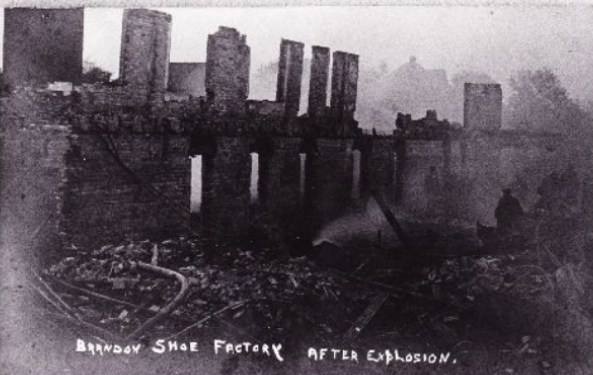
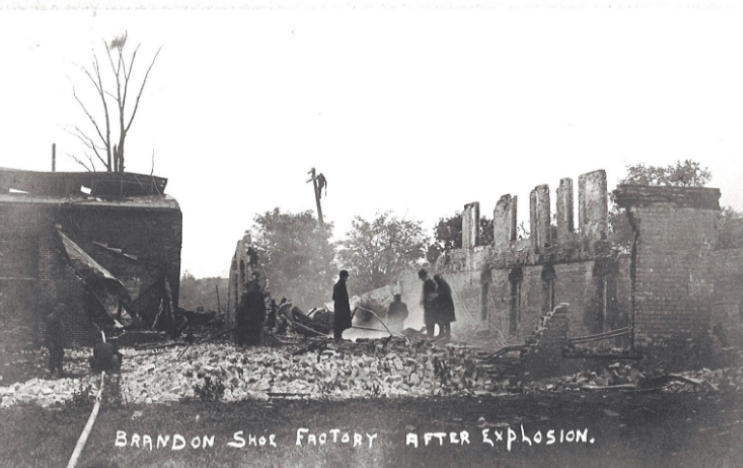
It was reported in the press at the time as the "worst disaster in the history of the town," and caused some $200,000 in damage, over $5 million today.
Within a year, a remarkably short time, a new Aylmer Shoe Factory, was rebuilt and opened on the site under new ownership.
The Aylmer Shoe Company was one of many important shoe and boot-making companies in Aylmer. As techniques progressed and the industry became more reliant on machinery and synthetic materials, however, there became less need for local shoemakers. Eventually, these technological changes nearly eliminated a once-key industry in Aylmer.
5. Canadian Canners Ltd.
Aylmer-Malahide Museum & Archives
The Myrtle Street Plant became the primary location of Aylmer's canning operations in 1913. By this time, the Aylmer Canning Company had joined with other canning companies to create Dominion Canners. When the factory pictured here opened, it was the largest canning plant in Canada. In 1919, the older canning buildings on Fourth Avenue were sold.1
* * *
Throughout the decades, two people remained at the forefront of the Canadian canning industry.
David Marshall was one of the founders of the original Aylmer business, and he purchased the Aylmer Canning Company to save it from financial ruin in 1886. In 1903, Marshall led the merger and became general manager of Canadian Canners Limited. He left J.J. Nairn to manage the Aylmer location.3 When Marshall passed away suddenly in 1920, Aylmer mourned his passing:
"A telegram was received here last Sunday morning announcing the death in the hospital at Vancouver on Saturday afternoon of David Marshall, one of Aylmer's leading citizens, one of Canada's leading businessmen and representative for East Elgin in the House of Commons for the past 13 years. He was accompanied on the trip by Mr. Innes of Simcoe, the general manager of the Company. From the word received, it is learned that Mr. Marshall was taken ill with influenza on Thursday while travelling on a train in B.C. and was removed to a hospital in Vancouver. Pneumonia developed causing his death on Saturday. In all his busy life, Mr. Marshall had never, it is said, experienced a day's illness until stricken with the malady which carried him off…Of Mr. Marshall, it can be truly said that he was a self-made man, he having risen from the ranks to the position of one of Canada's Captains of Industry, a representative of his home riding in the Dominion Parliament and perhaps the wealthiest man in Elgin. A record of his business career reads like a romance."
-The Aylmer Express, February 19, 19204
J.J. Nairn was the son of Thomas Nairn, an original investor in the Aylmer Canning Company. When Thomas Nairn passed away, Junius James (who was sometimes known as June) left his banking career in Wisconsin to fill his father's role at the canning company. Nairn served as president of the CCL from 1917 until his retirement in 1927. In 1930, he passed away. He was fondly remembered as well:5
"June' Nairn was born in Aylmer and lived here all his life. He began in the Exchange Bank and three years later was transferred to Head Office in Montreal for 5 years and then to a private bank in Wyoming, USA, for a few years. He returned home on the Death of his father in 1888…He was unmarried. All businesses closed in Aylmer during the hour of his funeral service. He is buried in Aylmer Cemetery."
- The Aylmer Express, August 28, 19306
Over the following decades, Canadian Canners Limited contributed to the war effort and continued to supply Canadians with a wide variety of canned goods. In 1956, the Del Monte Corporation purchased controlling interest in CCL, and in 1959, production at the Aylmer facilities halted and they were converted to storage spaces.7 In 1968, the factory was purchased by St. Pierre construction, and the building was demolished.
Since the 1950s Canadian Canners Limited has gone through a variety of purchases, changes of ownership, and rebrandings, but does continue exist today after a fashion as part of the Kraft Foods empire. Aylmer brand canned foods continues to be made, though ironically enough, not in Aylmer. Aylmer brand canned tomatoes, beets, and creamed core are still manufactured at a Dresden, Ontario, location. Aylmer brand soups are still produced at a plant in St. Hyacinthe, Quebec.9
6. Condensed Milk Industry
Aylmer-Malahide Museum & Archives
This photo was taken just after the Carnation Company purchased this condensed milk plant in 1916. In later years, the exterior of the plant was painted white. The first condensed milk plant located here was built by George Allworth in 1892 on the advice of David Marshall, who ran the Aylmer Canning Company. The building pictured here was erected in 1907 to accommodate the plant's expanding operations. After Carnation's purchase of the plant, operations continued in Aylmer until 1987, and the plant was demolished in 1993.1
* * *
- Maclean's, April 1, 19092
David Marshall was keen to expand Aylmer's business landscape, and he convinced George Allworth that Aylmer was the ideal location for his next condensed milk plant. Five years after this plant was built, Marshall and Thomas Nairn purchased it from Allworth. The operation was then absorbed into the Aylmer Canning Company label.3
"The other day I paid a visit to Aylmer and was surprised at the extent and substantial character of their factory, a splendidly equipped, fireproof structure of cement blocks and pressed brick, having a floor space of about 55,000 square feet."
- Maclean's Magazine, April 1, 19094
During its early years, the plant employed anywhere from 50 to 150 employees. At times, it operated 24 hours a day to keep up with demand.5
"A tour of the factory I found most instructive and interesting, and the process, from the time the milk is received until it is converted into the finished product, is one worth witnessing. From the receiving room the milk passes into the huge sanitary tanks of the cooling and purifying department. There it is held until ready to pass into the condensing department, where by the most modern sanitary machinery it is greatly reduced in consistency by evaporation in vacuuo. From here the milk goes into the filling department where automatically every can is filled, each containing the same quantity. The cans, after being hermetically sealed by special machinery, are next conveyed to the sterilizing department where they go through a secret process which renders the milk entirely free from germ life and puts it in a more digestible condition than fresh milk by greatly softening the casein. The milk is then held in the factory from thirty to sixty days to ensure it being in a perfect condition before it is placed on the market. This, in brief, is how the milk is transferred from the cow to the can in such a clean and sanitary manner, and is never touched by hand."
- Maclean's Magazine, April 1, 19096
The condensed milk plant went through many different owners, including Carnation Milk, Dominion Canners, Canada First, Aylmer Canning, and the Canadian Canners Limited. It was one of Aylmer's longest-lasting pieces of industry. The plant closed in 1987 after over 150 years of operation.
7. The Grand Trunk Railway
Aylmer-Malahide Museum & Archives
This 1910 photograph of the Grand Trunk Railway Station shows coal being hauled onto a locomotive while passengers stand outside with their baggage. By this time, the station had already been in operation for decades. It provided a transportation link for both passengers and products between municipalities in Ontario and Quebec.1
* * *
By 1861, the Grand Trunk Railway was deeply in debt. The company had misjudged the expense of rapid expansion, and investors were left with a deficit of several hundred thousand pounds. The railway company narrowly avoided bankruptcy through legislation that allowed for the reorganization of the company and the redistribution of finances.3
The Grand Trunk Railway was absorbed into the Canadian National Railway in 1923, a move which consolidated much of Canada's rail system under one management.
"The Air Line of the Great Western Railway was completed and running though Aylmer in 1872 and the Canada Southern, with a station three miles north, in the same year. The county of Elgin granted a bonus of $200,000 to the latter, which sum will require three years yet to clear off."4
The fates of many communities were decided by the railroad. If a small village was bypassed by a nearby rail line, it would often fade away to a ghost town without access to this valuable transportation network. Many local businesses, including Aylmer Canning, Imperial Tobacco, and a variety of farming enterprises, benefited greatly from the Grand Trunk Railway station in Aylmer.
8. Imperial Tobacco
Aylmer-Malahide Museum & Archives
Imperial Tobacco Canada built its John Street location in 1945, and the factory opened for operation in 1946. At its height, Imperial Tobacco employed nearly 600 people in this facility and processed millions of tons of tobacco every season. The plant closed its doors in 2007 after more than 60 years of operation.1
* * *
"The smoke is believed to be the pathway to the spirit world, and as such, carries all thought, feelings and prayers to the Creator…The smoke is not inhaled but allowed to drift up to the Creator."4
Often offered as a gift or in thanks, tobacco is associated with marriages, birth rituals, funeral practices, prayer, and ceremony. With the arrival of European colonizers, however, tobacco production was taken over and commercialized. In 1895, the Indian Act prevented Indigenous groups from selling what tobacco they had left, declaring such sales illegal.5
In southern Ontario, tobacco became an important trading item after the arrival of European colonists and traders. The Indigenous people of this area traded their tobacco with the Europeans in exchange for different goods. The flue-curing method for processing tobacco was developed in 1900. In flue-curing, tobacco leaves are hung to dry in a heated area to cure. This type of processed tobacco is still a major output of southwestern Ontario today. The region produces 90% of Canada's tobacco.6
The Imperial Tobacco Company started operations at its factory in Aylmer in 1946. Aylmer was an ideal location for such a venture not only because of its proximity to major delivery highways and railways but because of its central location amidst the area in which flue-cured tobacco grew. Over the years, Imperial Tobacco employed about 80 full-time workers and 500 seasonal employees on a regular basis. The Aylmer plant could store 110 million tons of tobacco. Twenty to twenty-five percent of the product was shipped internationally, and the majority was sent to Guelph to be made into cigarettes.7
In the 1990s, tobacco operations decreased, and in 2005, Imperial Tobacco began moving all of its operations to Mexico. The tobacco plant played a substantial role in Aylmer's early industrial development, however.8
Endnotes
1. Aylmer Canners: The Beginning
1. Barons, Kirk, A History Of The Aylmer Canners, Heritage Aylmer, 1981. 1.
2. Barons, 1.
3. Barons. 4.
4. Barons, 3.
5. Barons. 4.
2. Bishop Barker Company
1. Marshall, Tabitha , and Brereton Greenhous, and Mindy Gill-johnson. "Billy Bishop." The Canadian Encyclopedia. Historica Canada. Article published May 20, 2009; Last Edited August 16, 2021.
2. Tabitha, The Canadian Encyclopedia, online.
3. Tabitha, The Canadian Encyclopedia, online.
4. Butts, Edward , and Brereton Greenhous. "William Barker, VC." The Canadian Encyclopedia. Historica Canada. Article published January 29, 2008; Last Edited December 29, 2021.
5. Tabitha, The Canadian Encyclopedia, online.
6.Tabitha, The Canadian Encyclopedia, online.
7. Ralph, Wayne,"'They damn nearly did it for me': The story of William Barker, VC" Government of Canada. October 26, 2018. Accessed February 7, 2022, online.
8. Ralph, online.
3. The Mennonite Community
1. "Mennonite Church," Ohio History Connection. Accessed February 14, 2022, online.
2. "Mennonite Church," Ohio History Connection, online.
3. "A century ago," National Post. June 27, 2017, online.
4. Fast, Kerry, "A Brief History of the Migration of Mennonites to Ontario and the Formation of the Old Colony Church." Plett Foundation. Accessed February 14, 2022, online.
4. The Shoemaking Business
1. "The Aylmer Shoe Company Limited, 1913," Elgin County Archives. Item No. P20 1-2010-23.
2. Kelley, Frances. "Footwear Industry." <em>The Canadian Encyclopedia</em>. Historica Canada. Article published February 07, 2006; Last Edited December 16, 2013.
3. M.L. Aldrich, Aldrich's Pocket Directory of the Town of Aylmer. 1888. 39.
4. Aldrich, 54.
5. Aldrich, 75.
5. Canadian Canners Ltd.
1. Barons, 8.
2. Barons, 8.
3. Barons, 8.
4. Barons, 41-42.
5. Barons, 8-9.
6. Barons, 8-9.
7. Barons, 9.
8. M.L. Aldrich, Aldrich's Pocket Directory of the Town of Aylmer. (1888), 77.
6. Condensed Milk Industry
1. Archival Description of Item 2019-001-0026. Elgin County Archives, online.
2.Van Blaricom, G.B. "What a Pure Milk Supply Means," Maclean's Magazine. April 1, 1909, online.
3. Elder, Louise, The History of Canadian Canners Limited: 1903-1986. Scientific Research Department. 1986, online.
4. Van Blaricom, online..
5. Elder, online.
6. Van Blaricom, online.
7. The Grand Trunk Railway
1. Archival Description of Item No. G-28-2011-10. Elgin County Archives, online.
2. Marsh, James H.. "Grand Trunk Railway of Canada." The Canadian Encyclopedia. Historica Canada. Article published February 07, 2006; Last Edited June 03, 2015.
3. Bergen, Emily, "History of the Grand Trunk Railway." St. Thomas Public Library. August 2013.
4. Lavallé, Omer. "Canadian Pacific Railway." The Canadian Encyclopedia. Historica Canada. Article published March 06, 2008; Last Edited July 15, 2021.
8. Imperial Tobacco
1. "Our Story," Elgin Innovation Centre. Accessed February 11, 2022, online.
2. Johnson, P.w.. "Tobacco." The Canadian Encyclopedia. Historica Canada. Article published March 06, 2012; Last Edited March 04, 2015.
3. "Aboriginal Sacred Plants: Tobacco," Indigenous Corporate Training Inc. August 6, 2021. Accessed February 8, 2022, online.
4. "Aboriginal Sacred Plants: Tobacco," Indigenous Corporate Training Inc.
5. "Aboriginal Sacred Plants: Tobacco," Indigenous Corporate Training Inc.
6. Johnson, P.w.. "Tobacco." The Canadian Encyclopedia. Historica Canada. Article published March 06, 2012; Last Edited March 04, 2015.
7. Town of Aylmer, "Imperial Tobacco History." Elgin Innovation Centre. February 24, 2015. Accessed February 8, 2022, online.
8. Town of Aylmer, "Imperial Tobacco History," online.
Bibliography
Aldrich, M.L. Aldrich's Pocket Directory of the Town of Aylmer. 1888. 39. https://www.canadiana.ca/view/oocihm.8_00067_1/20?r=0&s=1
Aylmer Museum & Archives, Item No. 2003-015-0763. Accessed February 14, 2022.
Barons, Kirk, A History Of The Aylmer Canners, Heritage Aylmer, 1981.
Barons, Kirk. Low German Mennonites of Aylmer, Ontario 1950-1990. E-book.
Bergen, Emily, "History of the Grand Trunk Railway." St. Thomas Public Library. August 2013.
Butts, Edward , and Brereton Greenhous. "William Barker, VC." The Canadian Encyclopedia. Historica Canada. Article published January 29, 2008; Last Edited December 29, 2021.
Elder, Louise, The History of Canadian Canners Limited: 1903-1986. Scientific Research Department. 1986.
Elgin County"The Aylmer Shoe Company Limited, 1913," Elgin County Archives. Item No. P20 1-2010-23.
Elgin County, "Archival Description of Item No. G-28-2011-10". Accessed February 11, 2022. https://heritagecollections.elgin.ca/en/list?q=aylmer+railway+station&p=1&ps=20
Elgin County, "No.14 Service Flying Training School, Aylmer" Elgin County. Accessed February 1, 2022. https://www.elgincounty.ca/ElginCounty/CulturalServices/Archives/sww/Aylmer.html
Elgin Innovation Centre, "Our Story," Elgin Innovation Centre. Accessed February 11, 2022. https://www.elgininnovation.ca/about/
Fast, Kerry, "A Brief History of the Migration of Mennonites to Ontario and the Formation of the Old Colony Church." Plett Foundation. Accessed February 14, 2022. https://www.plettfoundation.org/articles/a-brief-history-of-the-migration-of-mennonites-to-ontario-and-the-formation-of-the-old-colony-church/
Garret, Carla, "Ontario Police College celebrates 50 years." Blue Line. January 12, 2012. https://www.blueline.ca/ontario_police_college_celebrates_50_years-2348/
Hogue, Tom. "Baby steps of food giants: Empires born in Hamilton, Niagara." Hamilton Spectator, Mar. 2, 2020. https://www.thespec.com/business/2019/10/09/baby-steps-of-food-giants-empires-born-in-hamilton-niagara.html
Indigenous Corporate Training Inc. "Aboriginal Sacred Plants: Tobacco," Indigenous Corporate Training Inc. August 6, 2021. Accessed February 8, 2022. https://www.ictinc.ca/blog/aboriginal-sacred-plants-tobacco
Johnson, P.W.. "Tobacco." The Canadian Encyclopedia. Historica Canada. Article published March 06, 2012; Last Edited March 04, 2015.
Kelley, Frances. "Footwear Industry." The Canadian Encyclopedia. Historica Canada. Article published February 07, 2006; Last Edited December 16, 2013.
Lavallé, Omer. "Canadian Pacific Railway." The Canadian Encyclopedia. Historica Canada. Article published March 06, 2008; Last Edited July 15, 2021.
Marsh, James H.. "Grand Trunk Railway of Canada." The Canadian Encyclopedia. Historica Canada. Article published February 07, 2006; Last Edited June 03, 2015.
Marshall, Tabitha , and Brereton Greenhous, , and Mindy Gill-johnson. "Billy Bishop." The Canadian Encyclopedia. Historica Canada. Article published May 20, 2009; Last Edited August 16, 2021.
National Post, "A century ago," National Post. June 27, 2017. https://nationalpost.com/news/canada/a-century-ago-our-families-left-the-prairies-and-moved-to-mexico-now-we-are-coming-home
North American Railway Hall of Fame, "Canada Southern Railway," North America Railway Hall of Fame. Accessed February 14, 2022. http://casostation.ca/history/canada-southern-railway/
Ohio History Connection, "Mennonite Church," Ohio History Connection. Accessed February 14, 2022. http://ohiohistorycentral.org/
Ontario.ca, "History of the College," Ontario.ca. Accessed February 14, 2022. https://www.ontario.ca/page/ontario-police-college
Ontario Provincial Police, "Ontario Provincial Police Historical Highlights 1909-2009," Ontario Provincial Police Museum. Accessed February 14, 2022. https://www.opp.ca/museum/historicalhighlights.php#:~:text=1867%20%2D%20This%20year%20marked%20the,Canadian%20Mounted%20Police%20(RCMP).
Town of Aylmer, "Imperial Tobacco History." Elgin Innovation Centre. February 24, 2015. Accessed February 8, 2022. https://www.elgininnovation.ca/imperial-tobacco-history/
Ralph, Wayne,"'They damn nearly did it for me': The story of William Barker, VC" Government of Canada. October 26, 2018. Accessed February 7, 2022. http://www.rcaf-arc.forces.gc.ca/en/article-template-standard.page?doc=they-damn-nearly-did-it-for-me-the-story-of-william-barker-vc/ivdi4oz9
Sims, Hugh Joffre, Sims' History of Elgin County. Elgin County Library, 1984. 41.
Van Blaricom, G.B. "What a Pure Milk Supply Means," Maclean's Magazine. April 1, 1909. https://macleansarchive.azurewebsites.net/article/1909/4/1/what-a-pure-milk-supply-means
Waymarking, "The Founding of Springfield," Waymarking.com. Accessed February 14, 2022. https://www.waymarking.com/waymarks/WMYXB9_THE_FOUNDING_OF_SPRINGFIELD



